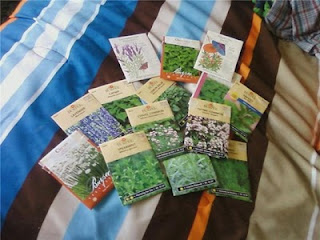
Now that it's late winter, spring is only around the corner, you may want to give your plants a head start, by starting seeds indoors. This is especially good for vegetables such as tomatoes, peppers, and eggplant. These crops should be started 6 to 8 weeks before the last frost. Starting your seeds early indoors is also good for many types of annuals and perennials, read the package instructions some plants need to be directly sown into the garden in spring, as they don't transplant well. Growing from seed is a cheap and economical way of growing many plants at a lower cost than buying starts at the nursery, as seeds are cheaper than buying already grown plants. Pick a Bright sunny area next to a window, that is warm, not drafty. You can also start seeds under florescent lights. I use a combination of the both.
First You will need some type of container to plant your seeds in, I prefer peat pots or pellets, as you can plant it directly into a pot or the ground outdoors, after the last frost, without disturbing the seedling's root system and the pot will just decompose.
Second get a good seed starting mix, if you use peat pellets you don't need this, as the pellets are made of seed starting medium.
Then you want to plant your seeds plant 2 seeds per cell, peat pellet, or peat pot. For small seeds just sprinkle on top of the planting medium and lightly press into the soil do NOT bury them , larger seeds need to be pressed into the soil more, slightly below the surface. Keep moist, I spray mine with water using a spray water bottle once every other day or so, you just have to check and see what the moisture level is like, you don't want it to dry out and you don't want it too wet either as this will kill the seedlings and or cause mold. Thin seedlings out after the begin to grow, remove the smaller seedling by breaking its stem, being careful not to disturb the roots of the larger seedling, this ensures that the larger seedling will grow healthy and strong. Read your seed packets or do research in book and or online before you plant your seeds some type of plants do better directly sown outdoors, as the do not like their root systems disturbed.
After your seedlings are a few weeks old and the last frost has passed you can move your seedlings outdoors, harden them off by placing them outside on cloudy days or in a shady spot, this helps let the seedlings adjust to growing outdoors, and so they don't get sunburned. Then you can transplant your seedlings into the ground or a larger container, when container gardening use an appropriately sized container with good drainage, only use potting mix, do not use potting soil or garden soil as these soils are to heavy and with hold to much water killing your plants, and garden soil may contain weed seeds. With these tips you should be able to grow many healthy plants from seed. Happy Gardening